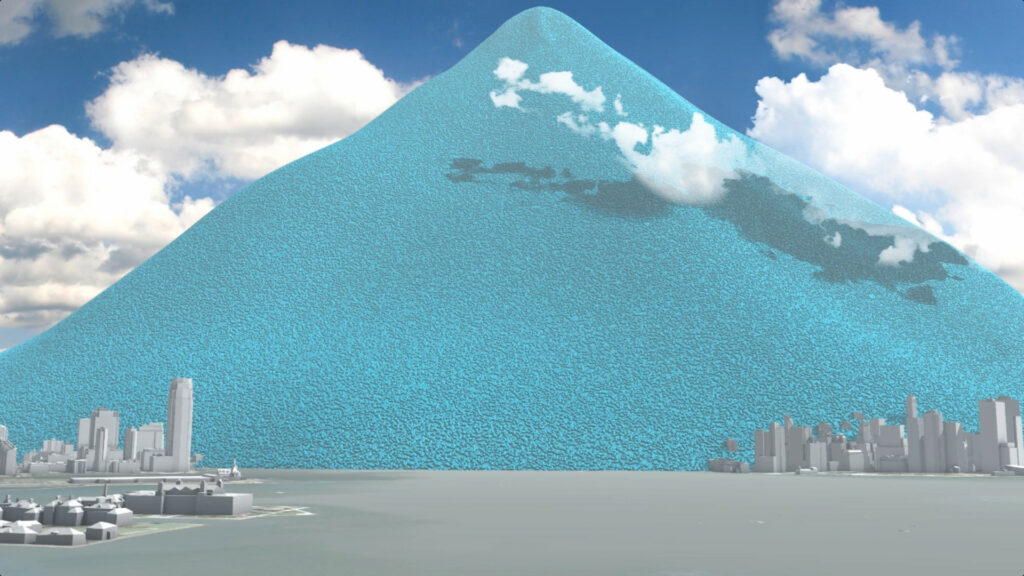Updated on 2024-03-06 by Adam Hardy
The simple definition of carbon footprint: a measure usually in kilos or tonnes of carbon dioxide (CO2) emissions which result from the person, organisation, service or object of discussion. So strictly speaking, it’s not about carbon – it’s about the CO2 emitted by burning it. Humanity’s global carbon footprint is huge – 50 Gigatonnes a year. CO2 is the most produced substance by mankind today.
In most situations, carbon footprints ignore the natural processes that happen without human intervention, processes that are a part of the natural carbon cycle that we learn about in school geography lessons. If there’s one thing to know about carbon footprints, it’s that they are messy and ill defined, or perhaps better said, constantly redefined by whoever is talking about them. Forest fires for instance produce huge amounts of CO2 which could be added to the carbon footprint for a state or country like Australia or California, but forest fires are a natural occurrence so that doesn’t happen.
A single person’s carbon footprint is the total of all the CO2 emissions they cause, if they add up everything from what they do or get, for every goods or service they use, including their fair share of the manufacturing, processing, packaging, delivery and servicing of that goods or service. It is easy to calculate our average carbon footprint, because it equals our fair share of the CO2 emissions that society pumps into the atmosphere. So we divide the population’s footprint by the number of people to get an average, but it is very difficult to work out what our actual individual carbon footprint is to see if our footprint is bigger than our neighbour’s. If we want to reduce it though, that is what we have to do, just like Weight Watchers count their calories.
There is more still. It’s not just CO2 – there are other greenhouse gases[1]The US government website gives the best overview of greenhouse gases (and survived Trump): https://www.epa.gov/ghgemissions/overview-greenhouse-gases which cause the Earth’s atmosphere to trap heat from the Sun and warm: methane CH4, nitrous oxide N2O, refrigerants composed of fluorinated hydrocarbons (like CFCs which caused the ozone hole). These greenhouse gases can be really potent, which is why the livestock industry with all its methane-belching cattle is such a big issue.
It is true that CO2 helps plants to grow, and that the world’s rainforests are absorbing more CO2 from the atmosphere as atmospheric concentrations rise, but make no mistake, humanity pollutes the atmosphere with so much CO2 from burning billions and billions of tons of fossil fuels, the Earth’s natural carbon cycle has been completely overwhelmed and we now face consequences on a planetary scale.

The situation though is not hopeless. Damage is and will continue to be done, for sure, but every kilo of CO2 that can be saved will make a difference. Ideally the oil industry would shut itself down quickly, but failing that everyone should do at least two things: contact their law-makers and political representatives to demand an end to oil, and strive to lower their own personal carbon footprint (and generally be as sustainable as possible).
An Industry Definition of Carbon Footprint
For those following the fossil fuel corporations closely, one definition of carbon footprints that is much used is the set of scopes (1, 2 and 3)[2]See this great run-down on scopes: https://plana.earth/academy/what-are-scope-1-2-3-emissions/
- Scope 1 – emissions released to the atmosphere as a direct result of burning fossil fuels, e.g. when transporting goods in a lorry that runs on diesel
- Scope 2 – emissions not directly from the company or organisation, that are caused by an energy provider for instance, which burns fossil fuels to provide energy that the company buys
- Scope 3 – all other emissions that result from the company or organisation’s activities but aren’t in scope 1 or 2, for example the emissions resulting from the burning of fossil fuels that an oil company sells – these are the company’s scope 3 emissions.
Scopes though are inappropriate for the task at hand – decarbonisation of the whole economy. Metrics like “Scope 1”, “Scope 2” and “Scope 3” only make sense for a small subset of companies, but they lack applicability, comparability, completeness, and reliability across the broad landscape of global emissions. What we need is granular carbon accounting – a carbon label on the product packaging, because citizens are correctly worried about the total carbon footprint of what they buy.
Businesses however take a less simplistic view of their carbon footprint, in an attempt to reduce what their declared CO2 emissions are. In many cases it takes effort to reduce CO2 emissions, and that will impact a business’s bottom line. Hence the more emissions associated with their products or services which they can disavow any responsibility for, the better for business it is. We can only expect strong resistance to carbon labelling and clear carbon footprint statements from commercial interests.
The definition of carbon footprint is essentially dependent on what the wider context of discussion is about. Units and measures, composition, origins, standards and comparability all play a part.
To request more information on any climate subject not covered here, please use the Contact form.
To take action personally both to reduce your own carbon footprint and to influence others in so doing, visit our climate action group, EcoCounts.
References
| ↑1 | The US government website gives the best overview of greenhouse gases (and survived Trump): https://www.epa.gov/ghgemissions/overview-greenhouse-gases |
|---|---|
| ↑2 | See this great run-down on scopes: https://plana.earth/academy/what-are-scope-1-2-3-emissions/ |

